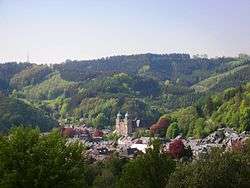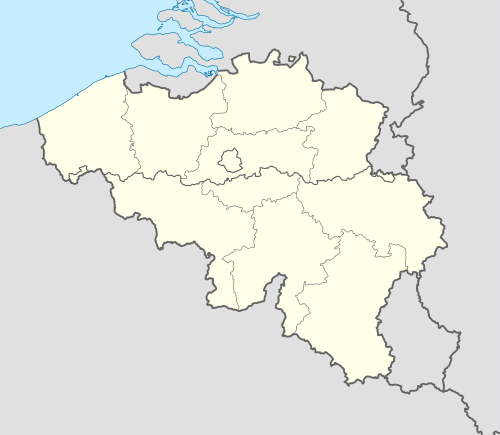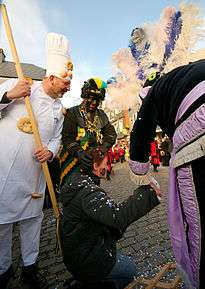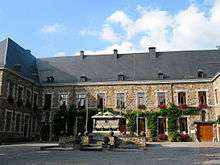Malmedy
Malmedy (French pronunciation: [malmədi]; German: Malmünd, Walloon: Måmdiy) is a Walloon city and municipality of Belgium. It lies in the province of Liège. On January 1, 2006, Malmedy had a total population of 11,829. The total area is 99.96 km² which gives a population density of 118 inhabitants per km².
Malmedy | |
|---|---|
 Malmedy from the south | |
 Flag  Coat of arms | |
 Malmedy Location in Belgium
Location of Malmedy in the province of Liège  | |
| Coordinates: 50°25′N 06°01′E | |
| Country | Belgium |
| Community | French Community |
| Region | Wallonia |
| Province | Liège |
| Arrondissement | Verviers |
| Government | |
| • Mayor | André Denis |
| Area | |
| • Total | 99.96 km2 (38.59 sq mi) |
| Population (2018-01-01)[1] | |
| • Total | 12,654 |
| • Density | 130/km2 (330/sq mi) |
| Postal codes | 4960 |
| Area codes | 080 |
| Website | http://malmedy.be |
The municipality consists of the following sub-municipalities: Malmedy proper, Bellevaux-Ligneuville, and Bévercé.
Under the complex administrative structures of Belgium, which has separate structures for territorial administration and for language community rights, Malmedy is part of Wallonia and of the French Community of Belgium. But since it has a German speaking minority, it is one of Belgium's municipalities with language facilities (or "municipalities with facilities"). Malmedy and Waimes are the two Walloon municipalities with facilities for German speakers. The population of Malmedy is approximately 95% French speakers and 5% German speakers.[2] The variety of German spoken is Moselle Franconian.
Geology
Seismic risks
In the Provinces of Liège, Limburg and Hainaut, seismic activity is higher than in the rest of the country. Malmedy is one of the communes in zone 2, that is to say, the zone most susceptible to earthquakes, in Belgium.
The earthquake of 1692, which touched the area of Verviers, as well as being responsible for landslides, took place in the valley of Warche east of Bévercé (in the south of the junction with the brook of Trô Maret). The remains and evidence, of these landslides, which affected the Conglomerate of Malmedy were discovered in March 2015. Ground surveys, subsequently, led to revisions of the local geological map.
History

The name of “Malmedy” comes from the Latin sentence “A malo mundarum,” meaning “purifying from evil”. The name originated due to regular flooding in the past from the Warche river, which passes through the town.[3]
The city was founded in 648 by Saint Remacle, Provost of Solignac abbey in France. He had established his Benedictine Monastery in Malmedy. Between this date and 1794, the history of Malmedy is linked to the religious Principality of Stavelot-Malmedy, a clerical microstate.
For 1,146 years, Malmedy and Stavelot together formed the Principality of Stavelot-Malmedy. Seventy-seven successive prince abbots of the Germanic Holy Roman Empire and the County of Logne led the state. However, a rivalry grew up rapidly between the two towns, because Saint Remacle decided to choose Stavelot as the main city of the Principality.
In the 16th Century, a significant number of industries appeared in the area of Malmedy: cloth, leather and gunpowder production. In the 17th Century, Stavelot-Malmedy became the most important tannery centre in Europe. But the main industry in Malmedy was the papermaking industry. It brought considerable wealth to the town.
In 1795, during the French Revolution and the Liège Revolution, the Principality of Stavelot-Malmedy disappeared and was united with France. Malmedy was a lower prefecture in the "département de l'Ourthe".[3]
After the defeat of Napoléon in 1815, during the Congress of Vienna, the decision was made to link Malmedy, a Romance and Walloon town, to Prussia, a Germanic state. This special situation of Malmedy caused a lot of problems in the first 50 years. However, the inhabitants were free to speak French as they pleased, including in the day-to-day running of the town council.
This situation changed when Chancellor Bismarck took power following the Franco-German War of 1870. For the Prussian Administration, Malmedy suffered a double disadvantage as it was both francophone and the majority of the inhabitants were Catholic. From this moment, Malmedy was forced to be Germanised. In schools, lessons in French were banned and the German language was mandatory. The priests were not allowed to preach any longer in French.[4]
During the First World War, the population of Malmedy fought in German uniforms. But when the defeat of Prussia was proclaimed, Malmedy and the other eastern cantons were annexed to Belgium by virtue of the Treaty of Versailles. Malmedy and neighbouring Eupen were subject to a plebiscite to determine whether the region would be separated from Germany and annexed to Belgium. The plebiscite ballots required registration of the names and addresses of the pro-German voters (the others were assumed to be pro-Belgian), and the German-speaking population of Eupen and Malmedy were intimidated. Both were formally annexed on 6 March 1925. The main church of Malmedy was built in 1777 and served as a cathedral from 1920 to 1925.[5] Some old sources spell the city's name "Malmédy" as this accent was intentionally added when being part of Prussia and Germany, but its official website lists it as "Malmedy", with no accent. Along with the neighbouring city of Eupen, it formed a German-speaking area of Belgium. This was reversed after the war. During this period, a few undaunted individuals went as far as founding a “Walloon Club” in 1897, and this still exists today.[6]
In 1944, during the Battle of the Bulge, the area was the site of the Malmedy massacre, where 84 American prisoners of war were executed by Nazi SS troops under the command of Joachim Peiper. This was one of a number of such massacres of prisoners and Belgian civilians which took place in the Malmedy area. Between 1940 and 1945, Malmedy was re-incorporated into Germany.
On 21 December the town itself, which was then held by US troops, was attacked by German forces under the command of Otto Skorzeny, who were repelled. Moreover, on 23, 24 and 25 December 1944 the city was bombed repeatedly by the United States Army Air Forces in a series of friendly fire incidents. Approximately 200 civilians were killed in the tragic attacks, while the number of American casualties has never been revealed by the United States Department of Defense.
Today, the people of Malmedy are a mix of Romance and German cultures. Despite all the changes, the Malmedians seem to have preserved the qualities recognised by an 18th-century English chemist when he stated, “The inhabitants of Malmedy are honest, skillful, opulent, gracious, sociable and courteous towards foreigners.”
Nowadays, the population consists of approximately 12,000 inhabitants, there are seven male choirs, two song groups, four brass bands, an accordion club, a mandolin club and a very active music academy.[7]
Climate
Malmedy has an oceanic climate with continental influences due to its inland position and higher elevation. Winter can see ice days, strong air frosts and snowfall. Malmedy's high precipitation is commonly affecting the nearby Spa-Francorchamps race track, known for its treacherous weather conditions.
| Climate data for Malmedy (1981–2010 normals; sunshine 1984–2013) | |||||||||||||
|---|---|---|---|---|---|---|---|---|---|---|---|---|---|
| Month | Jan | Feb | Mar | Apr | May | Jun | Jul | Aug | Sep | Oct | Nov | Dec | Year |
| Average high °C (°F) | 3.0 (37.4) |
4.2 (39.6) |
7.9 (46.2) |
11.8 (53.2) |
16.2 (61.2) |
18.9 (66.0) |
21.1 (70.0) |
20.8 (69.4) |
17.1 (62.8) |
12.6 (54.7) |
6.9 (44.4) |
3.7 (38.7) |
12.1 (53.8) |
| Daily mean °C (°F) | 0.5 (32.9) |
0.8 (33.4) |
4.1 (39.4) |
7.0 (44.6) |
11.3 (52.3) |
14.0 (57.2) |
16.2 (61.2) |
15.8 (60.4) |
12.5 (54.5) |
8.9 (48.0) |
4.3 (39.7) |
1.3 (34.3) |
8.1 (46.6) |
| Average low °C (°F) | −2.1 (28.2) |
−2.4 (27.7) |
0.2 (32.4) |
2.3 (36.1) |
6.4 (43.5) |
9.2 (48.6) |
11.2 (52.2) |
10.7 (51.3) |
8.0 (46.4) |
5.2 (41.4) |
1.7 (35.1) |
−1.0 (30.2) |
4.2 (39.6) |
| Average precipitation mm (inches) | 123.6 (4.87) |
104.1 (4.10) |
109.3 (4.30) |
79.5 (3.13) |
90.1 (3.55) |
97.4 (3.83) |
103.9 (4.09) |
97.6 (3.84) |
100.7 (3.96) |
102.3 (4.03) |
109.5 (4.31) |
128.9 (5.07) |
1,246.7 (49.08) |
| Average precipitation days | 15.3 | 13.3 | 15.1 | 11.9 | 12.6 | 12.9 | 12.7 | 11.9 | 12.2 | 12.7 | 15.0 | 15.9 | 161.4 |
| Mean monthly sunshine hours | 44 | 68 | 111 | 158 | 184 | 179 | 195 | 186 | 132 | 100 | 47 | 34 | 1,437 |
| Source: Royal Meteorological Institute [8] | |||||||||||||
Folklore

Inhabitants are proud of their Walloon language and their typical folklore. The people of Malmedy never miss the chance to celebrate a festival. The main celebrations in Malmedy are the “Cwarmê” (Carnival), the “Saint-Jean d’été” (Midsummer's Day), the “Saint-Pierre” (the annual funfair at Saint Peter's Day), the "Saint-Géréon" (in Walloon “Tribodlèdje”) and the Saint Martin's day (“Evêuyes”).
Cwarmê
The "Cwarmê", a Walloon word defining the Carnival of Malmedy, is the town's main festivity. Even though a part of the Malmedian culture is linked to the German culture, the "Cwarmê" of Malmedy is actually a Walloon and Latin carnival.
The celebration takes place from Shrove Friday to Shrove Tuesday, 40 days before Easter. The "Cwarmê" Sunday is the most important day. For the tourist, it's the opportunity to see the old traditional costumes in the streets (2,500 people in costume). The "Cwarmê" is depicted as a "street carnival" and is not only a parade: people who are disguised pass through the crowd and perform amongst them.
Some traditional costumes at the "Cwarmê" of Malmedy[52]:
- The "Haguète" is the most beautiful and most famous traditional costume of the "Cwarmê". She has a great hat with multi-coloured feathers and uses a form of long wooden tongs to catch the foot of a spectator.
- The "Longuès-Brèsses" (Long-bras in French, Long-arms in English) is a type of clown with long arms. He uses his arms to catch a spectator's hat which he then puts on the head of another person.
- The "Long-Né" consists of a group of eight people, each wearing a long-nose mask, a traditional blue smock and a long red & white cap. The group chooses a spectator in the crowd whom they follow and imitate until he offers them some beverages.
Image gallery
- Malmedy, central square
 Obelisk in the centre of Malmedy.
Obelisk in the centre of Malmedy. Malmedy Abbey, founded in 648, the sister of Stavelot Abbey
Malmedy Abbey, founded in 648, the sister of Stavelot Abbey Plaque next to the shelter where civilians had been hiding during the bombings of 23–25 December 1944
Plaque next to the shelter where civilians had been hiding during the bombings of 23–25 December 1944 Cwarmê of Malmedy with Long-Nés and Longuès-Brèsses.
Cwarmê of Malmedy with Long-Nés and Longuès-Brèsses. Cwarmê of Malmedy with Haguète and Arlequines.
Cwarmê of Malmedy with Haguète and Arlequines.
Noticeable residents
- Christian Brüls (born 1988), footballer
- Joseph Doutrelepont (1834-1918), German surgeon and dermatologist
- Marie-Anne Libert (1782-1865), plant pathologist and mycologist
- Guido Maus (born 1964), painter and sculptor
- Henri Pousseur (1929-2009), composer
- Bernd Rauw (born 1980), footballer
- Olivier Werner (born 1985), footballer
- Raoul Ubac (1910-1985), painter, photographer and sculptor
See also
- List of protected heritage sites in Malmedy
- Circuit de Spa-Francorchamps, with a corner named after Malmedy. Part of the track lies within the municipality.
References
- "Wettelijke Bevolking per gemeente op 1 januari 2018". Statbel. Retrieved 9 March 2019.
- http://www.malmedy.be/en/Tourisme/Malmedy/situation.html
- "History and Growth". www.malmedy.be. Retrieved 2016-01-07.
- "The Prussian Epoch (1815-1919)". www.malmedy.be. Retrieved 2016-01-07.
- Jean Finot. New York Times, May 30, 1915.
- "The Prussian Epoch (1815-1919)". www.malmedy.be. Retrieved 2016-01-07.
- "Malmedy Today". www.malmedy.be. Retrieved 2016-01-07.
- "Klimaatstatistieken van de Belgische gemeenten" (PDF) (in Dutch). Royal Meteorological Institute. Retrieved 29 May 2018.
External links
| Wikimedia Commons has media related to Malmedy. |
| Wikisource has original text related to this article: |
- (in French, German, English, and Dutch) Ville de Malmedy (Belgique), official website of the city of Malmedy.
- Veterans of the Battle of the Bulge (VBOB) Official online home
- Pictures from carnival Dominic Jacob
- (in French) Recettes Liegeoises et Ardennaises, Recipes from Malmedy and the Liege/Ardennes region.
- (in French) L'Etat belgique; données linguistiques
